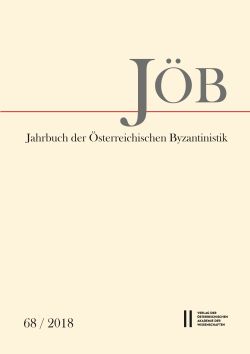Christophe ERISMANN
ist Professor an der Universität Wien in der Abteilung für Byzanzforschung und Modern Greek Studies
Christian GASTGEBER
ist Mitarbeiter in der Abteilung Byzanzforschung des Instituts für Mittelalterforschung der Österreichischen Akademie der Wissenschaften
Johannes PREISER-KAPELLER
ist Mitarbeiter in der Abteilung Byzanzforschung des Instituts für Mittelalterforschung der Österreichischen Akademie der Wissenschaften
Claudia RAPP
ist Professorin am Institut für Byzantinistik und Neogräzistik der Universität Wien und wirkliches Mitglied der Österreichischen Akademie der Wissenschaften
Elisabeth SCHIFFER
ist Mitarbeiterin in der Abteilung Byzanzforschung des Instituts für Mittelalterforschung der Österreichischen Akademie der Wissenschaften
|
 |
ISSN 0378-8660 Print Edition
ISSN 1810-536X Online Edition
ISBN 978-3-7001-8589-5 Print Edition
ISBN 978-3-7001-8489-8 Online Edition
Die Zeitschrift „Jahrbuch der Österreichischen Byzantinistik“ wurde 1951 als „Jahrbuch der Österreichischen Byzantinischen Gesellschaft“ gegründet und erhielt mit Band 18 (1969) ihren heutigen Namen. Trägerinstitutionen sind das Institut für Mittelalterforschung / Abteilung Byzanzforschung und das Institut für Byzantinistik und Neogräzistik der Universität Wien. Das seit 2019 neue Herausgebergremium wird in seiner Tätigkeit von einem wissenschaftlichen Beirat unterstützt, zusammengesetzt aus 15 international führenden Fachkolleg/inn/en. Beiträge werden auf Deutsch, Englisch, Französisch und Italienisch angenommen.
Die aktuelle Ausgabe umfasst neben einem Nachruf auf Peter E. Pieler acht Beiträge von F. Acerbi, D. Manolova, I. Pérez Martín, P. Agapitos, D. Angelov, P. D’Agostino, B. Bydén, A. Effenberger, K. Krause und D. Krausmüller, darunter vier Neueditionen byzantinischer Texte, sowie fünf Beiträge zum Themenschwerpunkt “Theodore the Stoudite on Traditions of Theological and Philosophical Thought” von Ch. Erismann, D. Krausmüller, B. MacDougall und K. Parry. Vier Buchbesprechungen schließen den Band ab.
Johannes Koder, Peter E. Pieler (14. Dezember 1941 – 1. Oktober 2018)
Artikel
Fabio Acerbi – Divna Manolova – Inmaculada Pérez Martín, The Source of Nicholas Rhabdas’
Letter to Khatzykes: An Anonymous Arithmetical Treatise in Vat. Barb. gr. 4
Pangiotis Agapitos – Dimiter Angelov, Six Essays by Theodore II Laskaris in Vindobonensis
Phil. Gr. 321: Edition, Translation, Analysis
Pietro D’Agostino, Un nouvel exemple de compendium logicum byzantin attribué à Théodore
Abū Qurra
Börje Bydén, The Byzantine Fortuna of Alexander of Aphrodisias’ Commentary on Aristotle’s
De sensu et sensibilibus
Arne Effenberger, Klöster zwischen Aspar-Zisterne, Deuteron und Goldenem Horn. Eine
topographische Untersuchung
Karin Krause, Celebrating Orthodoxy: Miniatures for Gregory the Theologian’s “Unread”
Orations (Ms. Basiliensis AN I 8)
Dirk Krausmüller, Two Middle Byzantine Treatises in Defence of the Care of the Dead
Vincent Nicolini, Empereurs et préfets du prétoire chez Jean le Lydien: les conditions du bon
gouvernement
Cluster: Theodore the Stoudite on Traditions of Theological and Philosophical
Thought
Christophe Erismann, Introduction
Christophe Erismann, “To be circumscribed belongs to the essence of man”. Theodore of Stoudios
on Individuality, Circumscription and Corporeality
Dirk Krausmüller, On the Relation between the Late Antique and Byzantine Christological
Discourses: Observations about Theodore the Stoudite’s Third Antirrheticus
Byron MacDougall, Aristotle at the Festival: The Orations of Theodore the Stoudite and
Byzantine
Logical Culture
Ken Parry, Theodore the Stoudite: The Most “Original” Iconophile?
Besprechungen
The Cambridge Intellectual History of Byzantium, ed. A. Kaldellis – N. Siniossoglou (Anna Sklaveniti)
Sarah Gador-Whyte, Theology and Poetry in Early Byzantium: The Kontakia of Romanos the Melodist (Antonia
Giannouli)
Derek Krueger, Liturgical Subjects: Christian Ritual, Biblical Narrative, and the Formation of the Self in Byzantium
(Daniel Galadza)
The Syriac Manuscripts of Tur ʿAbdin in the Fondo Grünwald, ed. V. Ruggieri (Grigory Kessel)
|

